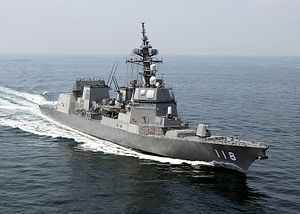The Japanese Maritime-Self Defense Force (JMSF) will join the Indian and American navies in this year’s installment of the Malabar naval exercise held in the Bay of Bengal, the Business Standard reports.
An announcement will be made shortly re-designating what had hitherto been officially an Indian-U.S. bilateral military exercise into a trilateral India-U.S.-Japan event, according to the Business Standard.
And while Japan’s participation is not new—the JMSF have joined in 2007, 2009, and 2014 respectively—it will be the first time that the Japanese Navy will not be a foreign invitee but rather a permanent member of the annual trilateral naval drill.
The Malabar exercises initially began as a joint Indo-U.S. naval drill in 1992. After a suspension from 1998 to 2002, due to India’s nuclear weapons tests in 1998, the exercise has been held every year since then under the watchful eye of China.
Previous participants include Singapore and Australia. Back in 2007, China went on the diplomatic offensive after the annual Malabar exercise had been dubbed a “concert of democracies” involving Australia, India, the United States, Japan, Singapore. Yielding to Chinese pressure, India reverted back to the bilateral Indo-U.S. format the following year.
Malabar 2015, held from October 14 to 19, will feature ten warships. The U.S. Navy’s fleet will include the nuclear-powered aircraft carrier USS Theodore Roosevelt, the Los Angeles-class nuclear-powered attack submarine USS City of Corpus Christi, and the new littoral combat ship USS Fort Worth, as well as a Ticonderoga-class destroyer.
The Indian Navy will dispatch a Rajput-class destroyer, a Brahmaputra-class frigate, a Shivalik-class frigate, a fleet support ship and a Sindhughosh-class diesel-electric submarine. India and the United States will also each field one P-8 Maritime Surveillance aircraft.
Japan will only participate with the Akizuki-class destroyer Fuyuzuki, commissioned in March 2014. The Fuyuzuki is specifically designed for anti-surface, and anti-submarine warfare and is also capable of engaging airborne threats.
The vessel is equipped with the ATECS battle management system, which has been called the “Japanese Aegis.” The Fuyuzuki also carries one Mitsubishi H-60 helicopter, an anti-submarine aircraft based on the Sikorsky S-70.
The combined fleet will engage in anti-submarine, anti-surface, and anti-aircraft weapon drills, according to the Business Standard.
As I reported previously, Beijing has been particularly worried over the naval exercise after a recent statement issued by the U.S. State Department noting the “the growing convergence” of the interests of India, Japan and the United States in the Indo-Pacific region, underlined by “the importance of international law and peaceful settlement of disputes; freedom of navigation and over flight; and unimpeded lawful commerce, including in the South China Sea.”

































